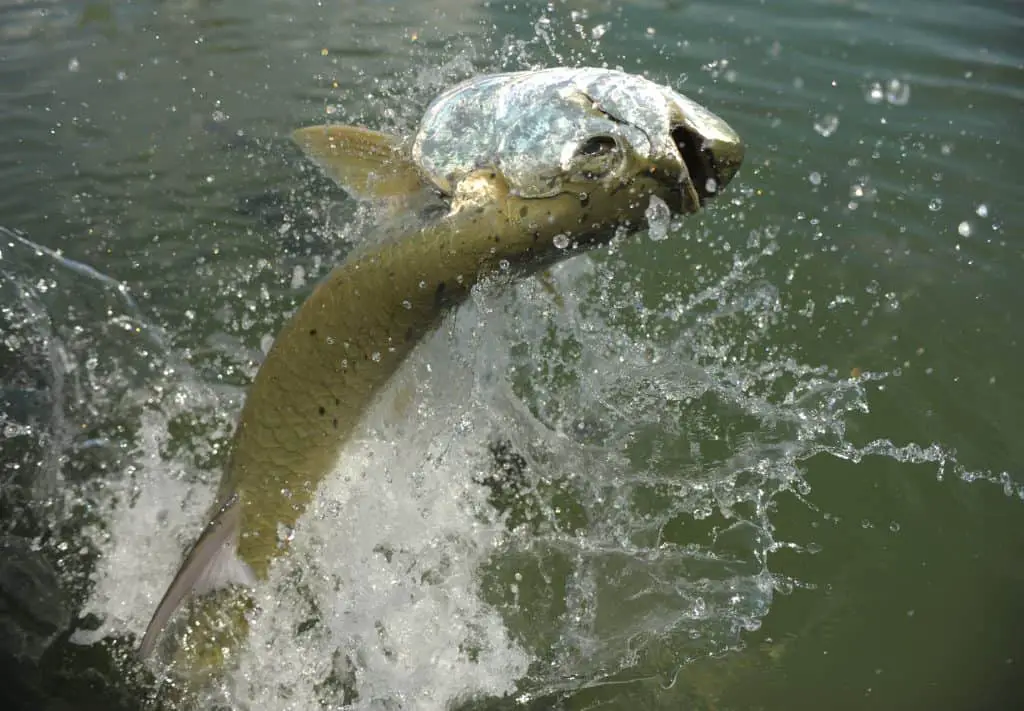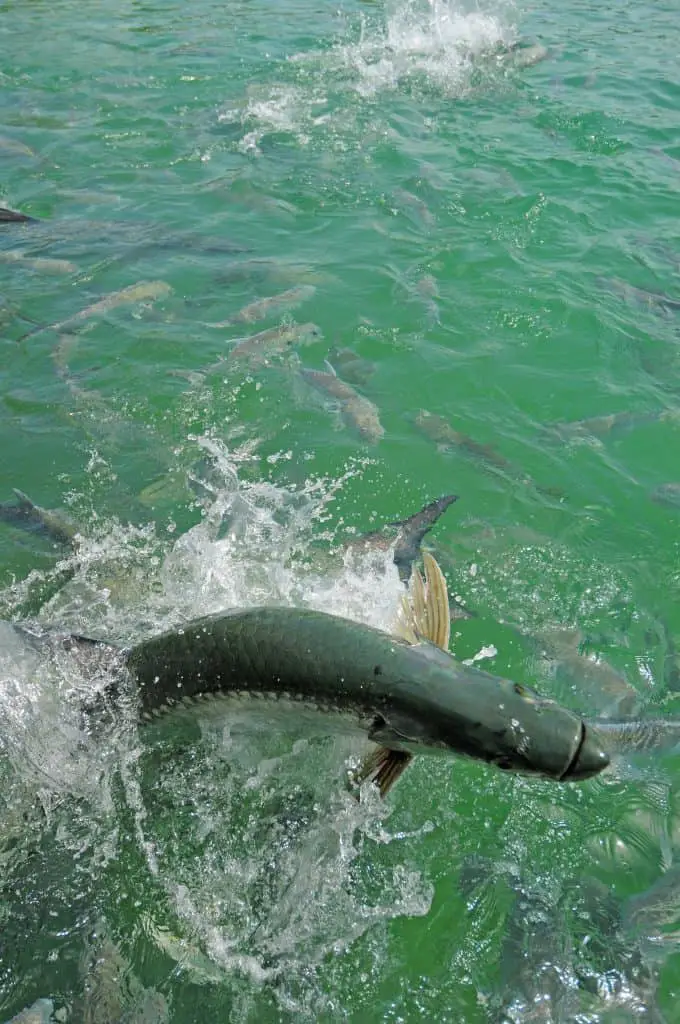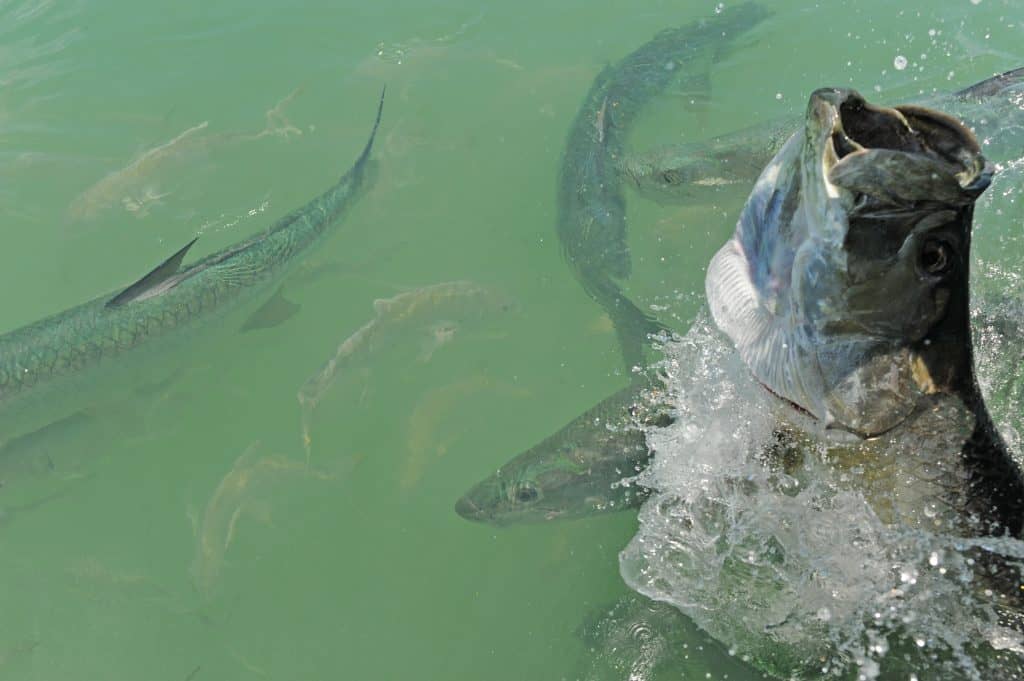As anglers, we can all agree that catching a tarpon is indeed an exhilarating challenge. This “saltwater catfish” is very common in South Florida and one of the most prized and appreciated game fish, because of its enormous size and forceful antics when hooked. However, that agreement ends when the topic of eating it starts.
Tarpon can be found all over the state, but can they actually be eaten? The answer is yes! Tarpon can taste like a cross between salmon and trout when cooked properly. Fresh tarpon has a white, flaky meat with an oily skin that makes it easy to remove from the bones.
Below, we have expanded on some interesting facts on tarpon, how it tastes and how to prepare it if you want to cook and eat it.

Facts About Tarpons
First things first, it is vital to know the basic information regarding tarpon before delving deeper into the subject of its edibility. Thus, I have included some simple but fun tarpon facts for you to achieve a better background and understanding of the topic.
Appearance
Belonging in the family of Megalopidae, tarpon are categorized into two species, namely the Indo-Pacific and the Atlantic. The latter is more massive of the two in terms of size, with an average length of five to six feet and a maximum weight of 350 pounds, which is common among adult types.
Meanwhile, the mature Indo-Pacific tarpon roughly reach three feet in length, but those living in freshwater environments do not extend as long or gain as many pounds.
Both species feature elongated bodies and silver-colored scales. Moreover, similar to catfish or bowfins, tarpon are equipped with attributes that empower them to adapt well. The most noteworthy of which is their swim bladder that serves as their lung, allowing them to break the surface and gulp air.
Habitat
Tarpon can dwell in various habitats, thanks to the swim bladder that enables them to survive poorly oxygenated bodies of water. Although most of them inhabit saltwater areas like bays, oceans, estuaries, and lagoons, some also spend their life in freshwater regions such as lakes, rivers, wetlands, and streams.
The Indo-Pacific fish species is found to be more prominent in freshwater environments compared to its Atlantic counterpart.

Behaviour
This kind of fish is often seen in groups called schools. Smaller schools of tarpon move into shallow areas to search for food.
Their diet actually differs based on age. Young tarpon typically feed on insects and zooplanktons such as fish larvae and krill, whereas adults prey on shrimp, pinfish, crabs, needlefish, and more, which they swallow whole. This is exactly the bait to put on your hook to catch this fish.
Likewise, tarpon transfer from one area to another not only to hunt but to breed as well. This happens when small schools of fish combine to become bigger in number and yield more eggs.
Also make sure to check out our related article on the best time to catch tarpon!
Reputation as the “saltwater catfish”
Tarpon are renowned for their undeniable “athleticism” that makes it challenging to keep them hooked at the end of the line. That is why many anglers devote time to learn fishing strategies and techniques to increase their chances of catching one.
It is also for this reason that tarpon are widely considered a significant game fish in the world of sport of fishing. See the video below for some nice fishing strategies and techniques.
Can you Eat Tarpon Fish
Now that you already know much more about this game fish, we can finally answer those million-dollar questions. Afterward, I hope that you would be able to draw some personal inferences that will definitely give you more avenues to master this subject matter.
Are Tarpon Edible?
To put it simply, yes the fish is edible. Tarpon, albeit definitely more unconventional than say salmon or trout, can be plated as food. The existing notion that refuses this claim is only a product of people’s popular aversion that stems from practicality. To expound, lots of fishers think that the arduous process of preparing the tarpon is not worth it because of the unsatisfactory taste.
On the other hand, tarpon can actually still be eaten without having to face the trouble of deboning. Yes, these massive fish remain edible even when served raw.
However, you should remember to choose only the ones caught from saltwater if ever you decide to eat it without cooking. This is because the salt in the water can eradicate harmful germs and bacteria present on the tarpon’s skin, ensuring that your health is not compromised when you try it.
How do Tarpon Taste?
As I already mentioned, numerous people who have dared to catch and eat tarpon complain about the fish being bony, having fishy smell and the taste, which they believe does not match the effort that goes into catching and preparing one to cook.
I may have to agree with them, because although the dish’s flavor is not particularly bad, tarpon meat has a strong odor and tons of bones that make it less enjoyable to eat. Nevertheless, like any other dish, the taste can still be enhanced by incorporating the right way of cooking and the right ingredients.
How to Cook Tarpon
The first thing that you may want to do when cooking a tarpon is to apply the proper cleaning procedures.
You may also discard the skin and fat from the fish before cooking it to prevent contamination. Finally, you should carefully perform the filleting and deboning methods to avoid swallowing any fishbone when you are eating. A food processor comes in handy for this as well!
Once you have that done, I highly suggest creating fish cakes out of your catch by following simple recipes, especially if you are just starting in the kitchen.
That way, you can secure that it is safe to eat since poaching and baking are included in the recipe. These processes can help remove any parasites as long as the meat will be heated at 145 degrees Fahrenheit or higher. As an added benefit, it gets rid of fish bones and also the smell!
My favorite tarpon recipe: Fish Cakes!
Many people love to eat fish cakes, but few actually decide to go through the trouble to cook them. Let me show you one really easy way to do just that:
- First, prepare the fish and fill a big pot with chicken broth. Put the fish inside and let it simmer for about 10 minutes. This also helps to get rid of the bones.
- Then, use a food processor or blender to create a paste out of your catch and mix it with egg, veggies, maybe some garlic and spices of your choice.
- Afterwards, pour a bit of flour on a work surface and roll your paste to make fish cakes out of it.
- Finally, cook them either in a pan with oil or simply bake them in an oven. The fish cakes need only about 3min frying or 15min at 350 degrees baking time to be good, as the fish has been cooked beforehand already.
If you follow these 4 simple steps, the process will yield delicious fish cakes from your catch, that are sure to turn heads.
Can you keep tarpon in a freezer?
Meanwhile, for those who don’t want to be bothered with cooking the same day, keeping tarpon inside a freezer at least one day before eating it will significantly contribute to destroying any remaining microorganisms present on its surfaces.

Conclusion
Tarpon are undoubtedly great fish to target while fishing, and they could be good dishes too if you have the energy to go through the task of deboning and cleaning them.
In case you have anything else to clarify or discuss, fire away on the comment section. For related posts on bowfin edibility, read here , jack crevalle here, perch here, pike here, flounder here, ladyfish here, marlin here, tripletail here, blobfish here, snakehead here, channel catfish here and koi here.
Before we part, let me emphasize these tips to bring you closer to a pleasurable eating experience with tarpon.
- Instead of just frying it, I greatly recommend that you poach and bake the tarpon meat into fish cakes to achieve a more delicious flavor. A food processor greatly facilitates this.
- POWERFUL 1500-WATT MOTOR: Crush ice, blend frozen fruit, and power through tough ingredients with the 2-horsepower motor, designed for professional results.
- TOTAL CRUSHING TECHNOLOGY: The XL 72-oz.* pitcher, ideal for large batches and entertaining, features Total Crushing Blades that crush ice to snow in seconds and powers through tough ingredients. *64-oz. max liquid capacity.
- ON-THE-GO CONVENIENCE: Includes two 16-oz. Nutri Ninja Cups with To-Go Lids, perfect for personalized shakes and smoothies.
- 8-CUP FOOD PROCESSING: Delivers consistent, even chopping, pureeing, and mixing. Includes a dedicated chopping blade, plus dough blade, capable of mixing up to 2 pounds of dough in just 30 seconds.
- VERSATILE FUNCTIONS: Choose from 4 functions – Blend, Mix, Crush, and Single-Serve – that best fits your recipe and meal prep needs.
- Never eat tarpon raw without freezing it for a minimum of 24 hours to avoid contracting foodborne illnesses.
- Appropriate cleaning and deboning procedures should be applied to guarantee not just a tasty treat but also a safe one.
